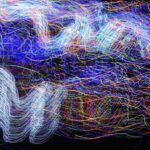The primary symptoms of epilepsy, alterations of consciousness in association with convulsive movements, are produced by disturbances in the electrical discharges of the brain cells. The abnormal firing of neurons is indicated by electroencephalographic (EEG) recordings which show not only unusual brain waves for epilepsy in general, but distinctive wave patterns for the four different types of seizures. The exact mechanisms which cause these electrical charges are still unknown, but they are believed to be biochemical changes which increase the excitability of the neurons and lead to irregular, explosive patterns of discharge.Even though new diagnostic techniques (including the implantation of electrodes) have succeeded in identifying brain pathology in the majority of cases, we know little about these important processes. The pathological condition may be due to a variety of causes: inflammations, fever, tumor,vascular disturbances, structural abnormality, and degenerative disease or brain injuries occurring before, during or after birth. Where brain damage can be found, the epilepsy is termed.“symptomatic”; where it cannot be found, it is termed “idiopathic”—that is, of unknown origin. Even in these cases there is believed to be a defect in brain cells, since the EEG patterns are abnormal, showing a diffuse rather than a focal cerebral dysrhythmia (irregularity). In addition, about 10 per cent of the general population show brain wave abnormalities. Although these individuals do not suffer from epilepsy they are believed to be more susceptible than others to seizures.Most authorities agree that there is a hereditary predisposition to epilepsy in the majority of cases of idiopathic epilepsy and a minority of symptomatic cases-—particularly when the seizures start early in life. Grand mal seizures have been found to occur three times more frequently in near relatives of idiopathic epileptics than in the general population, and the chances that they will occur in both identical twins are eight times greater than among fraternal twins. But even where there is a predisposition to epilepsy, there is usually a precipitating factor which irritates the unstable, hypersensitive nerve cells and leads to their abnormal discharge. Stimuli which provoke seizures in one individual may not do so in another. They include sudden sounds or certain musical notes (musicogenic epilepsy), flickering lights (photic or photogenic seizures), menstruation, emotional stress, or a heavy intellectual burden.The frequency of seizures varies greatly and in many cases seems to be closely related to the life adjustment of the patient. An individual who is subject to persistent conflicts, frustrations and tensions generally has more seizures than one who is rarely upset and leads a relatively satisfying, productive life. A recent theory holds that psychomotor seizures may serve the purpose of reducing tension, since some patients feel relieved after they have had an attack.In the past some investigators have claimed there is a specific “epilepticpersonality,” but more recent observers have discarded this idea. There is, however, a higher than average incidence of maladjustment among epileptics, due primarily to social rejection, insecurity, and job difficulties caused largely by the attitudes of employer or co-workers toward the disorder. Institutionalized patients sometimes react to their frustrations, and probably to the brain damage directly, by becoming irritable, rigid, self- centered and resentful. Significantly, office patients who live with their families do not exhibit undesirable traits nearly so often.Children who suffer from symptomatic epilepsy frequently show the same personality characteristics as many other brain injured children: hyperactivity, aggressiveness, and irritability. Those who suffer from idiopathic epilepsy tend to be especially self-conscious and uncomfortable in social situations. Frequently their feelings of inadequacy and insecurity are aggravated by parental overprotection or rejection, as well as by difficulties in competing with other children at school or on the playground. These reactions do not, however, constitute a specific epileptic personality pattern.The basic treatment for epilepsy today consists of medications which control the explosive activity of the nerve cells of the brain. Bromide salts (especially sodium bromide) were the major anticonvulsants from the middle of the nineteenth century to early in this century but have been almost completely discarded in view of their side effects and the danger of bromide intoxication. Phenylethyl barbituric acid (Phenobarbital), introduced in 1912, has proved to be a more successful drug and is still widely used for grand mal seizures as well as psychic equivalents, psychomotor seizures, and myoclonic attacks. It tends to produce drowsiness when first taken, but this effect diminishes if usage is prolonged. Though addiction is rare, dosages must be carefully controlled to avoid barbiturate poisoning.Sodium diphenyl hydantoinate (Dilantin Sodium), introduced in 1937, has less sedative effect than the barbiturates though it may produce such side effects as unstable gait, tremor, gastric upset, and skin eruptions. Many physicians have found it more effective than barbiturates in controlling seizures, both grand mal and psychomotor. In some cases it also leads to improvement in co-operation, alertness, and general attitude.Another anticonvulsant, methyl hy- dantoin (Mesantoin), has fewer side effects and is also widely used for grand mal, sometimes in combination with Dilantin, Phenobarbital, or related drugs such as Methobarbital and Mebaral. Three more recently developed drugs, phenylacetyl urea (Phenurone), primidone (Mysoline), and phenyl hydantoin (Peganone) are also administered both in grand mal and psychomotor cases, although special care must be exercised with Phenurone because of the possibility of liver damage and undesirable personality changes.The first important drug for the treatment of petit mal was trimethadione (Tridione), which came into use in 1945. Since that time other effective drugs, particularly paramethadione (Paradione) and phensuximide (Milon- tin) have been developed. The dangerous condition known as status epilepticus, in which one seizure rapidly follows another, is treated with massive intravenous injections of sodium phenobarbital, and if that fails, the physician tries a general anesthetic such as ether, chloroform, or sodium pentothal.Taken as a whole, the majority of epileptic patients must continue on medication indefinitely. Drugs can be discontinued in only about one-third of cases, after seizures have been eliminated for at least two years. There is no standard dosage for anticonvulsants. The physician must determine the most effective amount of the drug for each patient by experiment, and administer it under continuing supervision in order to avoid harmful side effects.












